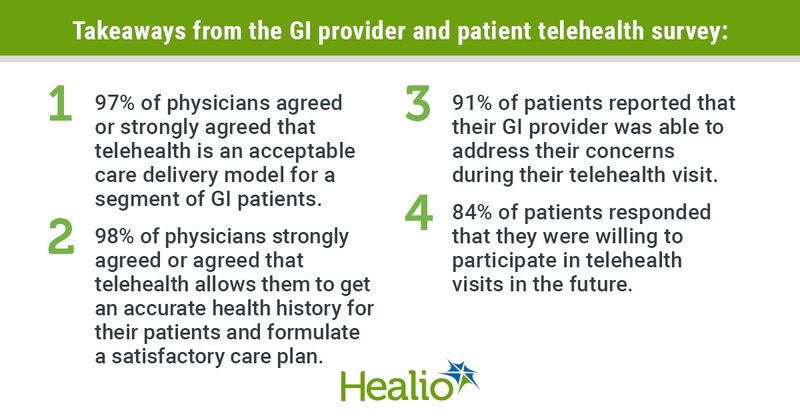GIs, patients highly satisfied with telehealth during COVID-19
Both patients and gastroenterologists have been highly satisfied with telehealth services during the COVID-19 pandemic, according results from a survey published in Clinical Gastroenterology and Hepatology.
Naresh T. Gunaratnam, MD, of Huron Gastroenterology Associates in Michigan, and colleagues wrote that policy changes that made telehealth more accessible have helped fulfill two critical aims of health care improvement.

“The response to the COVID-19 pandemic represents the first large-scale use of the telehealth model during a national crisis and it has been shown to be a useful innovation during times of disruption to our health care system,” Gunaratnam said in a press release. “The expansion of telehealth coverage by CMS and commercial payors in the face of the pandemic has helped us enhance the care experience and improve cost-effectiveness.”
Researchers sent an online satisfaction survey to 13,084 patients who participated in a telehealth visit between March and May at two community-based GI practices in Michigan and Washington, D.C. They also sent a survey to 95 independent GI practices comprising 2,220 providers.
As of June 17, 1,492 patients and 502 providers submitted responses to the survey.
The patient survey consisted of two question prompts; ““My GI provider was able to address my concerns during the telehealth visit,” and “I am willing to have more telehealth visits in the future.” Responders recorded their responses on a five-point scale, from strongly agree to strongly disagree. The survey also included questions on the kind of technology platform used, as well as reasons for the visit and demographic questions.
The provider survey included four questions: “Telemedicine is an acceptable care delivery model for a segment of GI patients,” “Telemedicine allows me to get an accurate health history for my patients and formulate a satisfactory care plan,” “Telemedicine allows me to provide timely testing and follow-through without interruption to patient care,” and “I will continue using telemedicine in my practice to deliver patient care.” Investigators also asked providers to project what percentage of their future care would be delivered via telehealth.
Researchers defined high satisfaction as at least 80% of approval (either strongly agree or agree) to individual survey components.
Gunaratnam and colleagues found that procedure-related visits, including prep and follow-up appointments, were the most common reason for a telehealth visit, while a desktop or laptop were the most used platforms (56%). Just 4.5% of visits were audio only. More than 80% of patients answered that their provider was able to address their concerns and that they were willing to participate in telehealth visits in the future, indicating that they were highly satisfied with their telehealth experience. The majority of visit reasons were also associated with high patient satisfaction.
Patients aged 85 years and older had the highest rate of satisfaction (95%), followed by patients aged between 75 and 85 years (93%).
Providers were also highly satisfied with their experiences. More than 90% of responders strongly agreed or agreed with all four question prompts. However, 54.1% of providers expected that less than a quarter of their future care would be done through telehealth, with 10.7% projecting that it would make up more than half of their future patient encounters.
“The transition to telehealth during the COVID-19 pandemic allowed us to continue providing patient care while reducing the risk of infection, which is critically important for elderly and immunocompromised patients and those with chronic health conditions,” James Weber, MD, of Texas Digestive Disease Consultants and president of Digestive Health Physician Association, said in the release. “Health care leaders, policymakers and payors must begin working together to strike the right balance between telehealth offerings and in-person care for a post-pandemic world.”

